]]>Article about Donatus Buongiorno published in academic journal
Day 12: Tuesday, 30 Ottobre 2018.
Napoli, Campania: Accademia di Belle Arti di Napoli.
My efforts to find out more about ancestor painter Donatus Buongiorno in Naples were thwarted at many turns, including his alma mater, the Accademia di Belle Arti di Napoli (Academy of Fine Arts of Naples.)
After a few false starts, and iffy leads to uninterested people, I finally hit pay dirt when my New York paintings conservator Luca Bonetti asked a conservator friend in Rome (Antonio Iaccarino Idelson, who doesn’t know me but thank you, Antonio!), who provided the name of Luciana Festa, who teaches stone (sculpture) conservation at the school.
See her talking about a recent project restoring Syrian sculptures here.
Luciana was the BEST. She talked to the school’s archivist and others before I arrived (a rarity among Italians, I’ve learned, who generally didn’t do anything until I was standing in front of them), and she sent answers to many of my questions in advance, which helped me plan the best use of my time on the ground.
We met for lunch and she provided the depressing explanation of why the school has no records of Donatus Buongiorno’s tenure in the 1800s: big fire after WWII bombardment by Allied forces burned up their archives. Mea culpa, mi dispiace. Not for the first time in Naples, I found myself apologizing for the actions of my army in the 1940s.
So I will provide the records “back to them!” I plan to submit a report of my ancestor’s career for their re-constructed archives.
Here’s the obligatory, blurry selfie of the two of us.

Day 11: Monday, 29 Ottobre 2018, a.m.
Napoli, Campania: Stazione Garibaldi, Metropolitana Linea 1.
Headed back to the apartment, I arrived at Stazione Garibaldi to the most taxing experience of my trip.
The ascensore (elevators) and scale mobile (escalators) were out of service, and men in uniforms with reflective safety vests were pointing people to the stairs. I couldn’t understand the guy’s explanation and figured I was being subject to an infamous Italian sciopero (labor strike).
The damned station is at least 150 feet underground and features four sets of elevators and four sets of stairs criss-crossing each other in a single, giant well that is open from the ground level to the tracks. I don’t like heights. The first time I exited Garibaldi station, I experienced nasty vertigo on the very long escalators out—which is why I had switched to using elevators (where you can’t see how high you are.)
This is the best photo I could find that is copyright-free (Thank you, Alpha 350.) Google other photos to get a stronger impression of how steep and dizzying these escalators and stairs are (45-degree angle.)

I said to myself, “Janice, pretend you have to do this to save your life, and just do it. Don’t look up, don’t look out, just look down at the stair treads until there are none left.” Resigned, I inhaled deeply and started up. It took about 10 minutes and wasn’t that bad, though I did have jelly legs for the rest of the evening.
I found out later the station was hit by a power outage.
During the 30 minutes that I was on the train, the whole city had been hit by a violent, windy thunderstorm—power lines down, roofs blown off, etc.
It was even reported in the New York Times, several friends from New York told me, with the mayor of Naples, Luigi de Magistris, calling it “an atmospheric earthquake,” whatever that is.
The lights in the station (of which there were plenty, no fewer than usual) must have been running on emergency generators. When I realized that, I wondered if the train had been running on generators, too, and quickly changed my attitude to “sure glad the damned thing made it into the station.”
I’ve worked for railroads, and I’ve taken their safety classes. I can tell you—enthusiastically—that I would be satisfied to never in my life experience walking in a train tunnel, in the dark, between tracks, with train personnel instructing me how to avoid hitting the third rail—thank you!
As the seven members of our party each arrived back at the apartment throughout the afternoon, we traded stories of waiting out the storm in museums, seeing loose pieces of roofs on the sidewalk in our neighborhood, and, for the family members who had returned to the apartment before it all started, closing the outside metal shutters and grilles on the windows, because the wind sounded strong enough to blow out the glass.
Later that night, we went out for pizza, and everything was more or less back to normal, surprisingly. Napoli has survived volcanoes. Not much else affects Neapolitani, apparently.
]]>Day 11: Monday, 29 Ottobre 2018, a.m.
Napoli, Campania: La Porta Capuana district, Via Cesare Rosaroll.
Back to Via Cesare Rosaroll and the slummy Troisi apartment with the whole gang. (See previous post for details.)
Lots of stunned silence—for the apartment and for the crappiness of the neighborhood in general.
We walked up Vico Cappella a Pontenuovo, a narrow street parallel to Via Cesare Rosaroll and Via Carbonara, to get a feel for an old neighborhood of Naples.
I’ve lived in un-modernized, cruddy tenement buildings in New York City, so this neighborhood didn’t faze me that much. Actually, I think it’s less bad than many inner-city neighborhoods I have seen (in the U.S. and all over Europe.) Some family members who are used to better housing were nonplussed.
What I did find wearying—claustrophobic, actually—after a week in Naples, and not just in this neighborhood, was the canyon-like narrowness of any street that was more than 200 years old and the overall darkness of buildings, sidewalks and streets, since the “local stone” is black, volcanic ash. Like this:

My favorite detail on Vico Cappella a Pontenuovo was the Spiderman motor cycle repair shop built into yet another tower of the former medieval wall of the city. See photo.

We saw these towers all over the neighborhood. Sometimes they were incorporated into later, substantial buildings, such as the well-known Garibaldi Barracks on Via Foria, and sometimes they had been turned into homes (!), such as the one shown below.
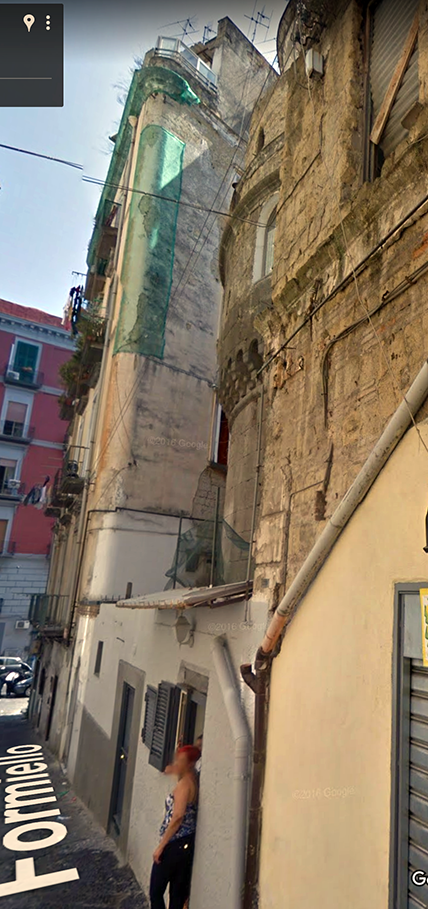

After the off-putting tour of the morning, we had a nice lunch to let everyone decompress, then we split to go several ways in smaller groups.

I headed south and west back into the old quarter to see Capella (chapel) Sansevero.
Giuseppe Sanmartino’s Veiled Christ is a stunning sculpture worth the money and effort, but the whole “attraction” is more cloyingly “touristy” than any other sights I had seen in Napoli, including the largest museums. I felt a tiny bit hustled, so I went into a “real” church afterward to relax for a few minutes.
Then I walked down the hill, explored a few new streets, and found myself on the musical instruments street that I had seen a week before with my Dutch friends. The “old” neighborhood is small enough that you can’t avoid repeating streets, I learned.
I headed to Piazza Dante and grabbed the metro to Garibaldi.
]]>Day 10: Sunday, 28 Ottobre 2018.
Napoli, Campania.
Sunday afternoon: family members arrive—two from Rome and three from Spain, joining one from Rome and one from Germany! The whole gang is now in Naples. We catch up on each others’ travels and make plans for dinner.
We can’t find the restaurant we chose from a guide book and “settle” for Avellinese food. It was fabulous.
A few nights later, when in Solofra, which is in Avellino, we ate at a “Neapolitan” restaurant. We couldn’t tell the difference, honestly.
Except that this category of not-pricey restaurants seems to always be overly lit, though I’m happy if they don’t have a t.v. blaring. (There’s often a calcio/soccer game on the t.v., but usually with the sound off which helps in ignoring it.)

]]>
Day 10: Sunday, 28 Ottobre 2018, a.m.
Napoli, Campania: Capodimonte Museum.
Julie and I got up early Sunday morning and booked it to the Capodimonte Museum, as the 19th-century apartments of the former palace residents are only open two hours a week, and I was determined to see every 19th-century painting in this city that Donatus Buongiorno would have seen while he lived here—in case I could identify copies, inspirations, etc.
There were no “finds” regarding his painting career, but there was a major find regarding a police action Buongiorno initiated in New York City in 1907. He reported a studio theft to the police—that a “Van Orley” painting had been stolen, a portrait of Protestant reformer John Calvin, which Buongiorno and an Italian art dealer had imported from Italy to sell in the U.S.
Buongiorno wasn’t treated very respectfully, as the casual racism and yellow journalism of reports in the New York Times and New York Sun reveal (“artistic hair,” “very broken English”.)
Bernard van Orley (c. 1487–1541) was a leading artist in Dutch and Flemish Renaissance painting and a designer of Brussels tapestries and stained glass.
He (and/or his workshop) made many portraits of European royalty, including seven of Charles V, Holy Roman Emperor, after he became King of Spain, and… on this Sunday morning, I discovered that the Capodimonte Museum has one of them! (The museum also has a substantial tapestry series based on van Orley drawings and, presumably, Buongiorno would have seen those, too.)
This confirms how Buongiorno would have known about van Orley, but I still suspect he “got taken” on the imported painting, as I find no record of a Calvin portrait by van Orley, though the two mens’ lives overlapped and van Orley was, against the tide, a Protestant.
So the plot thickens, and I have one more fact to add to the stew.
Many thanks to my cousin Julie Holm who shot a better photo of this painting than I did and is letting me post hers.

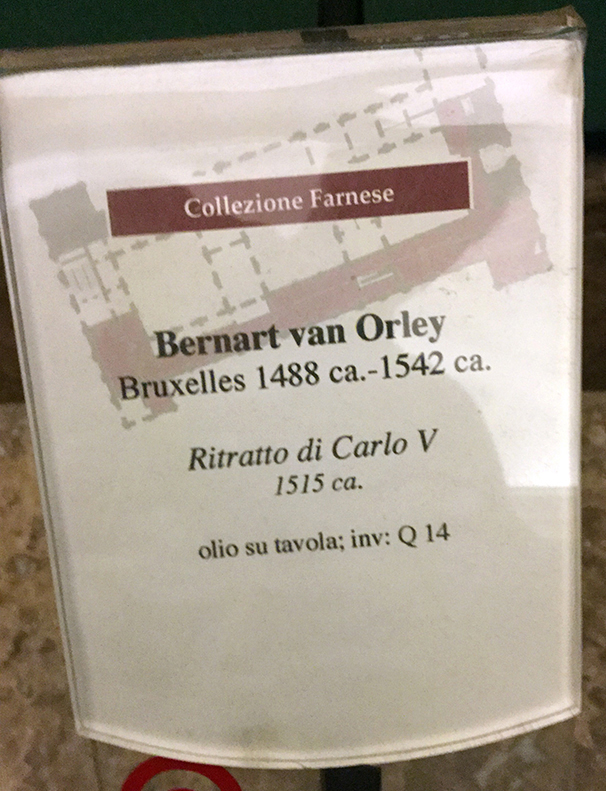
]]>
Day ?: Ottobre 2018, p.m.
Napoli, Campania: Corso Garibaldi.
I can’t remember which day this was, but the selfie is cute, and I wanted to put it in.

One night, Julie and I inadvertently crashed the family-only opening party of a new restaurant on Corso Garibaldi, a few steps from our apartment, right across the street from the Porta Nolana terminal station of the Circumvesuviana railroad.
We were hungry, and it looked good. There were quite a few people outside on the sidewalk and I said, “Oh it’s just the Italian smokers, we’ll cut through them.”
So we walked in. When we tried to navigate getting a table and menus, the (young) owner said: Don’t have any. We’re not open yet. But sit down and eat!
Then he proceeded to bring us drinks and taster-size food offerings, while children roamed around freely and nearby women made sure we had forks, etc.
They were so nice! And he wouldn’t let us pay him anything! He even insisted we take one dish with us, so we wouldn’t miss trying it.
Go there, people! The food was great!
Gusto & Passione
Corso Giuseppe Garibaldi, 42-43, 80142 Napoli NA, Italy
Phone: +39 081 1820 5856
]]>Day 8: Friday, 26 Ottobre 2018, morning.
Napoli, Campania: Il Sindaco al Palazzo Municipio.
I heard the mayor (sindaco) of Naples, Luigi de Magistris, speak in New York in 2015, when he made a round of visits to Italian American institutions to promote tourism to Naples. He was forthcoming, interesting, and charming.
A former prosecutor, he has a very interesting resume (Google him), and he’s a reformer with big plans for improving Naples. Indeed, only three years later, I experienced results of his work: garbage piles in the streets are gone, all of the subway stations are finished and open, and petty/preying street crime is down—thanks to military-style police with assault rifles who patrol in pairs in tourist areas (see blue circle in photo.)

Since I heard de Magistris speak, I’ve had it in mind to bait his office when I visited Naples, because why not?
So I wrote to the man in New York who organized the talk I attended with my pitch: My family is visiting Naples as a result of de Magistris’s visit to New York. (Never mind that I’ve been researching my Neapolitan genealogy for 10 years, I was prepared to give de Magistris full credit for the trip.) After leaving in 1907, we are the first to return, and wouldn’t he like to have a film crew follow us around to make a tourist promotion? We will be very entertaining, and we will only say good things about the city. Plus I have this fascinating project about a family member who was an artist who left in 1892.…
The man wrote me back a very polite note saying not sure about your proposal, but here’s the name of de Magistris’s assistant with whom I made the New York arrangements.
Pay dirt!
I wrote to the assistant: “My family is visiting Naples, and….”
She wrote back “We don’t have a film crew, but would you like a tour of city hall?”
Hell yes!
So Julie and I went to the Palazzo Municipio on Friday morning to check out the tour and see if it was worth doing again with family members the following week. We decided “no” for the family (not germane, limited time), but we had a blast.
Here’s the outside of the building.
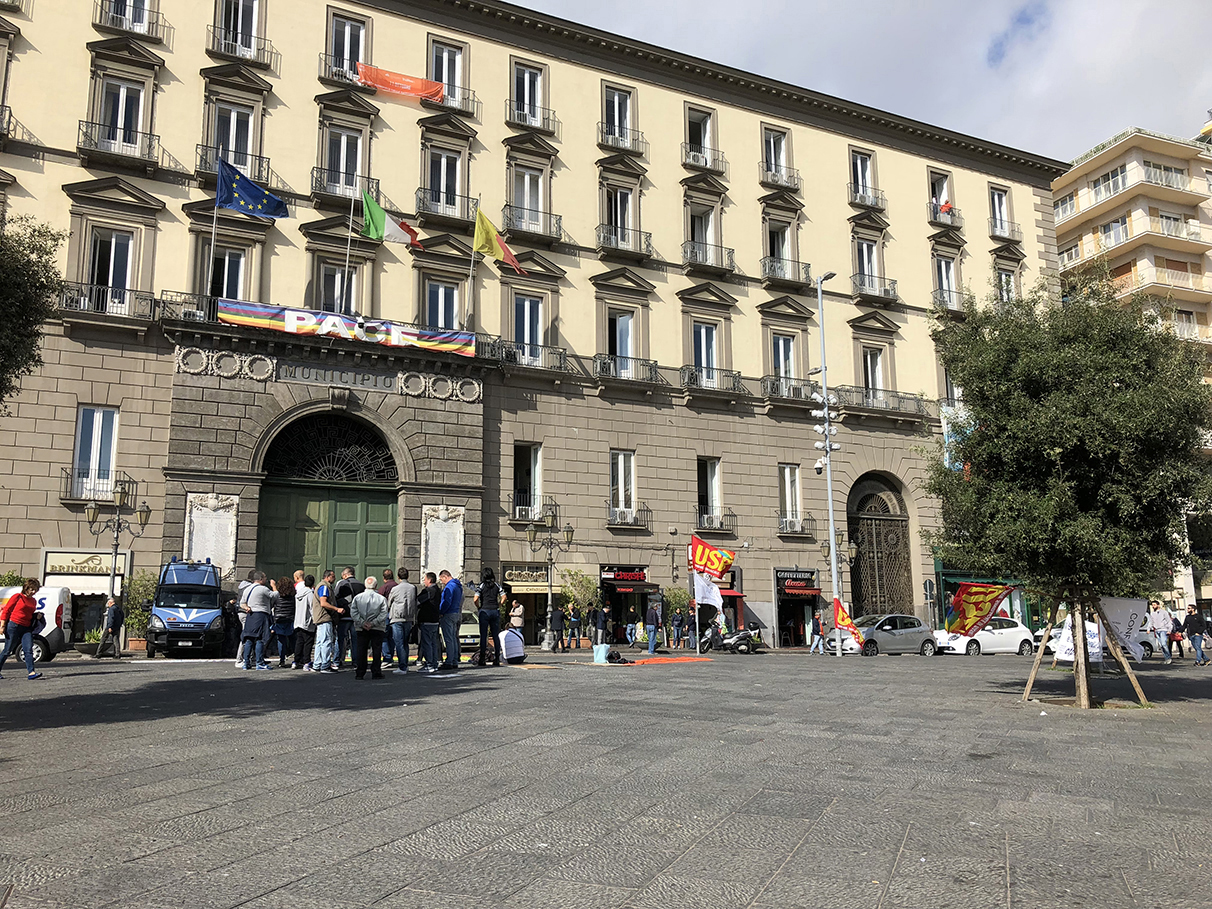
We walked up to that gaggle of police officers around the green door, and I announced, “We have an appointment with Il Sindaco.”
Not this door. Go around to the side.
So we go to the side and talk to the municipal officers who are smoking cigarettes. “We have an appointment with Il Sindaco.”
They make some phone calls and yell to other people who are further inside and go back to smoking.
We wait. We wait. We look at each other: not sure we are going to get in here.
Then these two youngsters appear: Alessia Andreottola and Dario Riccio. They are our guides.

We walk in. No bag check. No pat down for weapons. No passports, no IDs. No security whatsoever. Interesting.

The palazzo is one of the many royal houses, or offices, or something, that were left over when Naples became a not-royal city upon the unification of the country. It’s a fancy building, with fancy rooms, and fancy decorations all over the walls and ceilings. Paintings, sculptures, and decorative objects everywhere.


There’s even a Precepio. Apparently Christmas lasts year-round at City Hall.
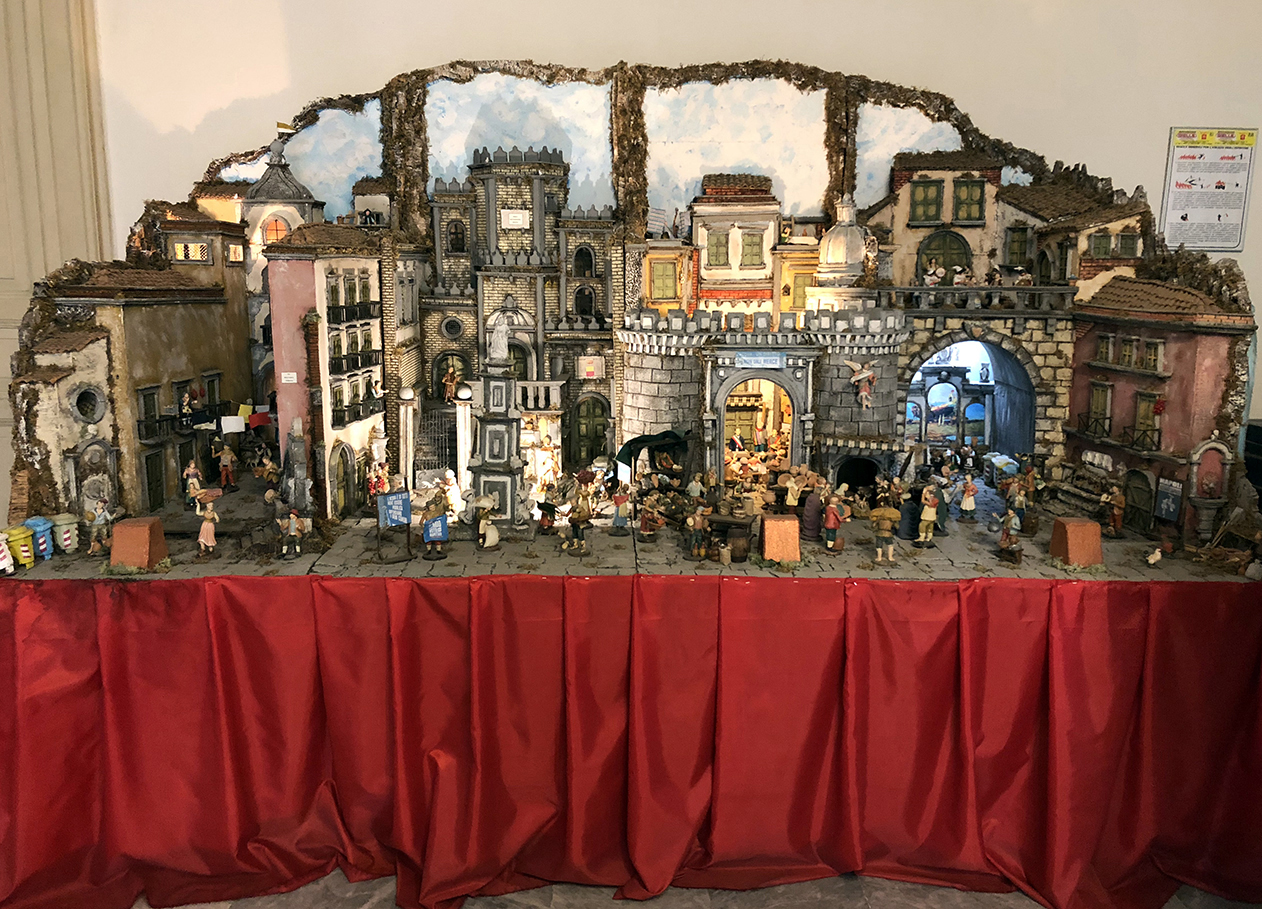
At one point, we stood outside a room full of people and looked at their heads from the hallway. Signor de Magistris is in there, but he’s doing a press conference, so you can’t meet him. Now we’re in an Altman movie: cue soundtrack of action in one room, talk from other room washing over us, people near the door turning around to “Shhhhh” us.
Would we like to see his office instead?
Sure.
We enter the corner room, filled with ornate furniture, and, on every surface, including every square inch of Signor de Magistris’s desk, are mementoes and tchotchkas with his name on them. Gifts from all quarters, apparently. Julie whispers to me, “He must have another office, too. Doesn’t look like much work gets done in this one.”



Look at that 19th-century painting. Could it be a Buongiorno, pleeeeease? (Not.)

Would we like a photograph of his desk. “Umm, okay.” We take one. No, would we like to SIT AT his desk. (So we can slip the plastic explosive under it more easily?) Surrrre. So I played potentate, and Julie stood behind me, and our guide shot a photo.

Who do they think we actually are, we wondered? (We didn’t notice anyone following us the rest of the day.)
Go to Naples, people! You can tour the mayor’s for-show office!
While I was chatting with the minders to distract them, Julie snagged a great shot of the newly re-opened Piazza Municipio from the mayor’s fourth floor window. Note the 1930s port building (behind the yellow crane) on the cruise ship docks beyond, and cloud-covered Mount Vesuvius 5 miles away.
De Magistris gets full, well-deserved, credit for the reconstruction of the piazza and for construction of the Metro station underneath it (note red M sign on pole and discreet entrance to station–stairs down surrounded by cement retaining wall–in front of the building on the right).

Here’s the obligatory selfie. A million thanks to my cousin Julie Holm who shot all these photos.

]]>
Day 8: Friday, 26 Ottobre 2018.
Napoli, Campania: Vomero Hill.
Cousin Julie and I, who are doing advanced scouting for a condensed visit with family members who will arrive in a few days, decided that seeing this view from this Naples hill is a must-do/must-see, so we are re-arranging the group schedule to include it next Tuesday when museums will be closed. Julie shot the two panorama photos (with her extra phone, which she had lent to me, but then I gave it back—our identities were a little blurred at this point).





Day 7: Thursday, 25 Ottobre 2018.
Napoli, Campania: Via Cesare Rosaroll, 8:00 p.m.
Dinner?
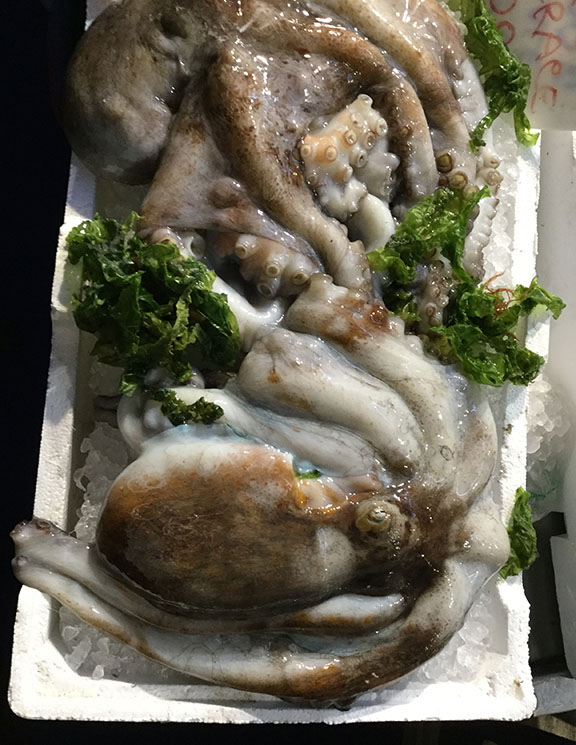
Day 7: Thursday, 25 Ottobre 2018.
Napoli, Campania: La Porta Capuana district.
My grandfather told us (in his 1970 self-published memoir) the street where his family lived, but not the building/apartment number. I hired several people to pursue different avenues to get that elusive number, and one paid off. (Shout-out of thanks to Vincenzo Regina of Istituto Araldico Genealogico del Regno di Napoli.)
5:00 p.m.: I announce to my cousin Julie, “I just got the notice from my hired researcher. Maria Michela Buongiorno (Troisi) died in her home located in Vico Santa Caterina a Formiello n. 3.”
We immediately look up that address on Google Earth.

It’s bad, people. It’s a tiny hovel of a doorway, a few crooked steps above the street, across from a toilet paper store. (Seriously, the store is even labeled “paper” on Google Earth.) Currently not occupied and possibly for rent or for sale (see sign in photo)—anyone, anyone? Not directly on Via Cesare Rosaroll, but in a nearby alley. No wonder Domenic Troisi (my grandfather) had no complaints about a 4-room tenement flat in New York City (in 1907) and so enjoyed his later, self-built, 4-bedroom home in Williamsport, Pa., in the 1920s. The man did well for himself in the U.S., eh?
5:01 p.m.: Julie says, “Let’s go look at it. Right now.”
Update, later in the evening: Wrong door. The grilled door on the right is to the building’s common hallway and stair to upstairs apartments. (Totally dark, filled with trash.) The apartment is the OPEN door to the left—where you can see the current occupant’s refrigerator just inside (on Google Earth, but she has moved it since.) It’s the size of a small Manhattan studio apartment—no smaller than some I’ve lived in—but 4 inches above the street, with a single wooden door between her and and a public street while she sleeps. What you see in the photo below is about the full width of the entire 4-story building, by the way, so the apartments upstairs may not be any wider.
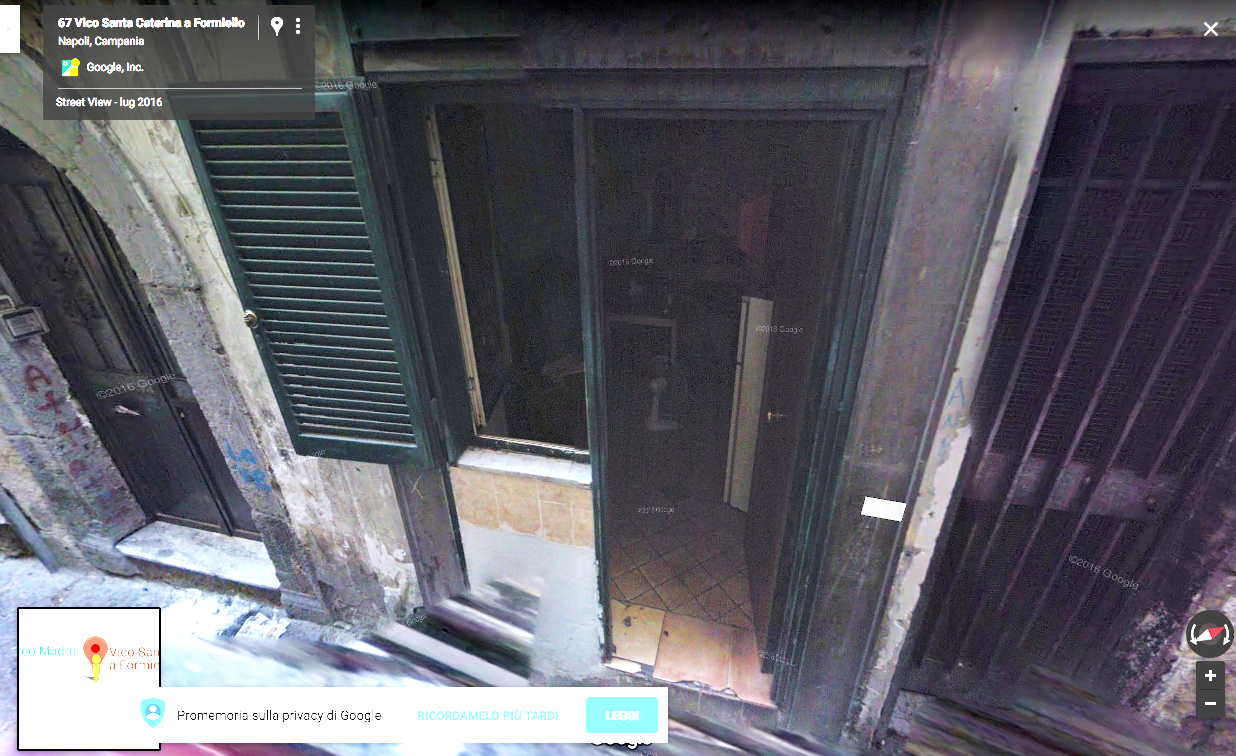
The currently inhabitant is a woman from the Dominican Republic (to the left in the photos, the woman to the right is her friend who lives elsewhere) who has lived in Italy 20 years. She very graciously chatted with us a few minutes, while cars whizzed by my back a few inches away and cousin Julie discretely took a few photos. (Thanks for the use of your photos, Julie.)


Troisi cousins note that the apt matches Domenic’s description for magazino in the front, living quarters behind a curtain in the back. You can see an alcove with curtain to the right of her friend in the doorway photo. The current tenant has an electric refrigerator and nary a wood stove in sight. We did not ask if her toilet is still out in the hall (which our grandfather reported in his memoir).
The last photo shows a chapel on the street that we think must be the one Domenic referred to in his memoir.

By the way, the “toilet paper store” across the street, which I jokingly identified based on stacks of toilet paper in the Google Earth image? Sells only paper. We confirmed it. I feel compelled to include the photo as proof.

See posts by my other family members on Facebook for photos and videos taken during daylight on the day we all visited together, including this good overview by my sister Loraine. Thanks, Loraine.

Day 6: Wednesday, 24 Ottobre 2018.
Napoli, Campania: From the apartment in La Marinella district.
My first view of Vesuvius from the apartment!

Day 6: Wednesday, 24 Ottobre 2018.
Napoli, Campania: Museo Archeologico di Napoli.
My first view of Vesuvius! From the archeology museum. (The weather’s been cloudy. Views have been lousy ’til now.)
Taken from an open window on the top floor. My Dutch friends who are with me are outraged that this room containing frescoes from Pompeii has windows that are open to the elements as we stand here. “Don’t they know anything about climate control and conservation?!?!” (Yes, they do, but this is not a wealthy country like The Netherlands….)

Day 5: Tuesday, 23 Ottobre 2018.
Napoli, Campania: Palazzo Zevallos Stigliano, Via Toledo.
In the week before my family arrived in Naples for our “roots tour,” I viewed every collection of 19th c. paintings in the city, part of ongoing research of my ancestor painter Donatus Buongiorno—wanting to “see what he saw” and understand his visual education.
The collection at this mid-sized gallery includes a “famous” maybe-Carravagio, 17th- and 18th-century paintings that would have informed Buongiorno’s work, as they were most likely on view somewhere else in Naples (possibly Museo Pignatelli) when he lived and studied there. This gallery, opened only a few years ago, is a re-arrangement of paintings owned by a Neapolitan bank.
Plus, the gallery is in a former palazzo, and I’m always a sucker for architecture.
Rooms of more recent art contained late-1800s pieces by Buongiorno’s contemporaries and teachers from the Accademia di Belle Arti di Napoli, including a beautiful bust of Domenico Morelli (by Vincenzo Gemito, number 8 in the slide show at the bottom of the website page), an influential art educator of Naples who was an instructor in painting at the art academy when Buongiorno attended and who later became the academy’s director.
Unexpectedly, I was jolted, and thrilled, to see pride of place given to a painting by Francesco Guarini (or Guarino)*, 1611-1651 or 1654, who was a painter from Buongiorno’s home town of Solofra, Avellino.

Giovanni Tommaso Guarini and his son Francesco Guarini painted the murals on the ceilings of their famous, 17th c. Neapolitan Baroque hometown church La Collegiata di San Michele Arcangelo.
If nothing else, having this painting in this gallery’s collection helps secure Guarini’s importance as a southern painter and draw some attention to him, and to Solofra, in the big city of Naples.
*There’s debate over the painters’ last names being Guarino vs. Guarini. Here is a Google translation of the last paragraph of the Wiki article:
It is not yet known precisely what the last vowel of the original surname of the artist is. Although this debate, reopened on the occasion of the celebrations for the four hundred years since the birth of the Solofrano painter (1611-2011), seemed to converge towards the final choice of “Guarini”, some scholars reiterate the thesis that it should instead call it “Guarino”. In the publications of various authors both definitions are used, therefore it is possible to define both Guarini and Guarino, without making mistakes.
As there is a Guarino in my Troisi family tree—Maria Vincenza Guarino, 1824-1866 or 1883, mother of Beniamino Mimi Troisi—I declare her to be a descendant of these two painters and, hence, another source of the substantial artistic abilities manifested by multiple generations of my family.
]]>Day 4: Monday, 22 Ottobre 2018.
Napoli, Campania, La Marinella neighborhood.
Train from Rome: Notes for family members who are duplicating this trip in a few days.
There are two train companies that run trains from Rome to Naples. One costs 12 euros and is the “local”. Takes 3 hours, stops at 8 or so towns along the way, including several outlying areas of Naples that we were told are known for drug dealing where dealers and beggars get on the train to transact business and harass passengers. We were told that the trains are old, crappy, not maintained inside, broken seats and you might not get a seat and have to stand the whole way.
We saw the interior of one of these trains as we were leaving the platform in Naples, and it looked no worse than your typical NJTransit or LIRR train to me.
Side note: There is a palpable prejudice against “southerners” in this country. Every single Roman who gave us “advice” about Naples railed on and on about how frightening everything would be. Plus, I am writing this a day later and have spent a whole day walking around the city already. No problems! I think the nasty reports are exaggerated. Yes, we saw a few beggars. No, they were not that aggressive.
The other company is Italotreno.it. Costs 40 euro and is worth it. Takes 1 hr 10 mins, stops once, is a fast, smooth, pleasant ride. I recommend it highly. Brand new tracks, even the gravel they are set in looks clean. For those of us who only know train travel on 100+ year old tracks of the northeast corridor of the U.S., this is a revelation. I watched the train cross two lines at a switch at one point, and you could only barely feel the bump from within the car. I especially encourage Dave H the engineer to choose this option for the “infrastructure experience.”
Plus, we went through, and got glimpses of, this exciting, spectacular, new Napoli Afragola station by architect Zaha Hadid!!!
You can book at their website (assigned seats), but it’s not a smooth interface and took us an hour. Honestly, I think we could have done as well just showing up 20 mins early and buying the seats at the station. We traveled at noon on a weekday and the train was full but not completely sold out. Both stations have segregated spots for buying tix that are less busy than the general station and out of traffic, so you don’t feel nervous handling your cash, credit card, etc.
Speaking of which, no problem using American credit cards to buy stuff so far. Even the tabacchi stands take cards for bus tickets—1,50 in Rome, 1,10 in Naples. (Everything is cheaper in Naples, sometimes by half. Wait ’til you get to Naples to buy routine stuff, if you can.) Last night I used a credit card in a small, family owned restaurant—though I had to go to the “special” cashier to do it which was an amusing adventure.
Both railroad stations — Roma Termini and Napoli Central — are big, busy, typical major city stations and NOT the crime-infested dens of thieves that many report. They are certainly not “relaxing” spaces, never are, but neither did we feel especially besieged or threatened—and we were three typical looking tourists with the screaming clue of dragging wheeled bags. Both stations had visible security, European-style: camo uniforms, machine guns. Architecturally, both are well-designed and interesting. Also completely modern and logically functional (enter building, pass through a “court” containing ticket selling and food, continue straight ahead to tracks and platforms—which are called “binario” in Italian), unlike, say Penn Station in New York which is a compromised horrible mess of urban non-planning. In Rome, you can show your ticket for admission to a segregated waiting area along the heads of the train tracks, which is less busy than the main concourse.
Apartment in Naples: We walked from the station to the apartment in Napoli, which was easy, took 15 mins. I’ll draw a detailed map and send it to everybody, as the nest of streets immediately around the apartment building isn’t the clearest, but also isn’t “bad.”
The apartment is in a batch of buildings that look 1960s era, my guess. From outside, they are ugly. Plain surfaces, not “tidy” looking maintenance, but functional. Also, as in many European cities (especially in hot climates), a/c and sometimes also electrical hearing units are installed on the outsides of buildings, plus all kinds of other crap, such as clothes lines, antennas, meters, etc. (see photo), that make the buildings look like hell, in my opinion (I do care about aesthetics, mind), but they’re not as lower class as my American judgment assumes. Inside: tiles and marble surfaces, neat, clean, no problems.
Our apartment is huge, by city standards. The rooms are bigger than they look at the booking website. Everything is clean and works. I’ve seen worse plumbing and more dysfunctional appliances in many, many places I have stayed (and lived).
There’s not much of a view. The building is surrounded by other hideously ugly buildings, but you can see the weather and get some light. (Unlike, for example, the hotel I just left in Rome, where I had a closet-sized room facing an interior “court”—air shaft—where I couldn’t do either.) My travel guest reports that you can see Vesuvio from our balcony (which adjoins two of the three bedrooms), but I haven’t been out there yet.
You don’t have to “hide” that you’re moving in. We waited in the lobby area of the building for the owner’s rep to arrive to let us in. It was her secretary: Valeria. Vittoria is a lawyer and has an office somewhere nearby. We didn’t meet her. The doorman/guard called Valeria for me (meaning, he knew that the apartment was rented to transients and he knew the lawyer’s office phone number.) Other residents said “Buongiorno” to us while we loitered in their lobby. (If it were NYC, people would quiz you and/or call the cops.) It doesn’t seem to be a secret that there are transients in this unit, nor does anyone seem to care.
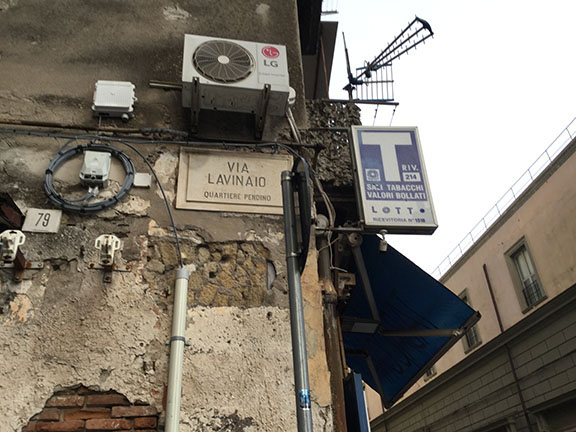
Day 4: Monday, 22 Ottobre 2018.
Napoli, Campania, La Marinella neighborhood.
We are in Napoli, and, ragazzi (guys), the apartment is fabulous! Huge rooms, good location and look at this rainbow, which appeared outside the north-facing balcony of the apartment within minutes of our arrival. I choose to believe my (long dead) grandfather Domenic Troisi delivered this to welcome us to his hometown. The train from Rome was easy, convenient, comfortable and really fast (150 miles/hour we estimated.) I will post directions for the train later to help other family members who are coming from Rome next week.

New York, USA, 13 Ottobre 2018.
Our family has a street in Naples!
In advance of our trip, I am communicating with this lovely man, Alfonso Buongiorno, who owns a leather tanning business in Solofra. (https://www.facebook.com/profile.php?id=100015900452619)
He thinks he is related to us like this: Biagio Buongiorno, father of our Great-grandmother Maria Michela Buongiorno Troisi and of artist Donato/Donatus Buongiorno, was a brother of his Great-great-grandfather Michele Buongiorno. (Update Nov 18: Later, when meeting him in person, Alfonso said there were two male cousins with the names of the ancestors we know, which means the ancestor in common is those two mens’ grandfather. This might be a translation issue. I will sort it out based on comprehensive documents Alfonso gave me, and will post definitive information later.)
He will meet us in Solofra on Nov. 1 and show us his family history book with his family tree!
He reports that the Buongiornos have been tanners and goldsmiths (not of jewelry, I learned later: gold leafing of leather and other interior furnishings, such as columns, capitals, walls) in Solofra for centuries, and that some of them went to Naples during each generation to facilitate trade. (Residency was required to get a license for trade, I learned later.)
In Naples, still today, there is a Vicolo Buongiorno, which dates from the time when goldsmith Buongiornos were on the street. (Vicolo, also Vico, means alley.)
Guess what. It’s only a few blocks from Via Cesare Rosaroll where Domenic Troisi and his family lived in 1907 right before they migrated to the U.S.
The plot thickens….
Check it out on Google Earth and see how glamorous Vicolo Buongiorno is today. https://www.google.com/maps/place/Vico+Buongiorno,+80137+Napoli+NA,+Italy/@40.8560405,14.2553281,19z/data=!4m5!3m4!1s0x133b086941cb0da9:0xdec1e3b3eece833c!8m2!3d40.8560405!4d14.2558753
We come from class, people!
